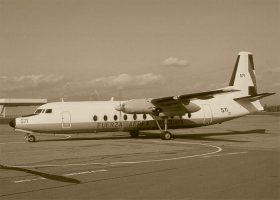THE CRASH
On October 13th, 1972, a Uruguayan rugby team boarded a plane in Montevideo, Uruguay to play a match in Santiago, Chile. When they were only halfway there, inclement mountain weather forced them to stop for an overnight stay in Mendoza, Argentina. The next day, when weather conditions were not improving, the pilot made the decision to take an alternate route to Chile - over the Andes mountain range.After resuming the flight on the afternoon of October 13, the plane was soon flying through the pass in the mountains. The pilot then notified air controllers in Santiago that he was over Curico, Chile, and was cleared to descend. That proved to be a fatal error. Since the pass was covered by the clouds, the pilots had no idea how long it would take to cross the pass. He failed to take into account strong headwinds that slowed the plane and increased the time required to complete the crossing. He was not as far west as he thought, and turned the plane downward too soon.
Dipping into the cloud cover while still over the mountains, the plane soon crashed on an unnamed peak (later named Glaciar de las Lagrimas, or Glacier of Tears), straddling the remote mountainous border between Chile and Argentina. The plane clipped the peak at 13,800 feet, neatly severing the right wing, which was thrown back with such force that it cut off the vertical stabilizer and left a gaping hole in the rear of the fuselage. One of the propellers sliced through the fuselage. The fuselage hit the ground and slid down a steep mountain slope before finally coming to rest in a snow bank.
EARLY DAYS
Of the 45 people on the plane, 12 died in the crash or shortly thereafter; another five had died by the next morning, and one more succumbed to injuries on the eighth day. The remaining 27 faced severe difficulties in surviving high in the freezing mountains. Many had suffered injuries from the crash, including broken legs from the aircraft's seats piling together. The survivors lacked equipment such as cold-weather clothing and footwear suitable for the area. They lacked any kind of medical supplies, and the only doctor on the flight, Dr. Francisco Nicola, died in the crash.THE SEARCH
Search parties from three countries looked for the missing plane. However, since the plane was white, it blended in with the snow, making it virtually invisible from the sky. The initial search was cancelled after eight days. The survivors of the crash had found a small transistor radio on the plane and Roy Harley, one of the survivors, first heard the news that the search was cancelled on their 11th day on the mountain.Upon hearing the news, the survivors began to sob and pray - all except Gustavo Nicolich, who looked calmly up the mountains which rose to the west. 'Hey boys,' he shouted, 'there's some good news! We just heard on the radio. They've called off the search.' Inside the crowded plane there was silence. As the hopelessness of their predicament enveloped them, they wept. 'Why the hell is that good news?' another shouted angrily at Nicolich. 'Because it means,' Nicolich said, 'that we're going to get out of here on our own.' The courage of this one man prevented a barrage of total despair.
DESPERATE TIMES
The survivors had a small amount of food: a few chocolate bars, assorted snacks and several bottles of wine. During the days following the crash they divided out this food in very small amounts so as not to exhaust their meager supply. Nicolich also devised a way to melt snow into water by using metal from the seats and placing snow on it. The snow then melted in the sun and dripped into empty wine bottles. Even with this strict rationing, their food stock dwindled quickly. Furthermore, there was no natural vegetation or animals on the snow-covered mountain. The group thus survived by collectively making a decision to eat flesh from the bodies of their dead comrades, beginning with the pilot. This decision was not taken lightly, as most were classmates or close friends. In his 2006 book, Miracle in the Andes: 72 Days on the Mountain and My Long Trek Home, Nando Parrado comments on this decision:At high altitude, the body's caloric needs are astronomical... we were starving in earnest, with no hope of finding food, but our hunger soon grew so ravenous that we searched anyway... again and again we scoured the fuselage in search of crumbs and morsels. We tried to eat strips of leather torn from pieces of luggage, though we knew that the chemicals they'd been treated with would do us more harm than good. We ripped open seat cushions hoping to find straw, but found only inedible upholstery foam... Again and again I came to the same conclusion: unless we wanted to eat the clothes we were wearing, there was nothing here but aluminum, plastic, ice, and rock.
Not all passengers participated in cannibalism.2 Others refused at first, though after realizing that it was their only means of staying alive, changed their minds a few days later. Reports show that they only consumed the flesh of those who had already died, though some questions remain about how some of those people died.
THE HIKES
On December 12, 1972, some two months after the crash, three of the 16 survivors began their trek up the mountain to search for a sign of human life. Parrado took the lead, and often had to be called to slow down, though the thin oxygen made it difficult for all of them. It was still bitterly cold but a sleeping bag allowed them to live through the nights.On the third day of the trek, Parrado reached the top of the mountain before the other two. Stretched before him as far as the eye could see were more mountains. In fact, he had just climbed one of the mountains (as high as 15,260 feet) which forms the border between Argentina and Chile, meaning that they were still dozens of miles from the green valleys of Chile. However, after spying a small "Y" in the distance, he gauged that a way out of the mountains must lie beyond, and refused to give up hope. Knowing that the hike would take more energy than they'd originally planned for, Parrado and Canessa sent Vizintín, the third hiker, back to the crash site, as they were rapidly running out of food.
Parrado and Canessa hiked for several more days. First, they were able to actually reach the narrow valley that Parrado had seen on the top of the mountain, where they found the bed of Rio Azufre. They followed the river and finally reached the end of the snowline. Gradually, there appeared more and more signs of human presence: first some signs of camping and finally, on the ninth day, some cows. When they rested that evening, they were very tired and Canessa seemed unable to proceed further. As Parrado was gathering wood to build a fire, Canessa noticed what looked like a man on a horse at the other side of the river, and yelled at the near-sighted Parrado to run down to the banks. At first it seemed that Canessa had been imagining the man on the horse, but eventually they saw three men on horseback. Divided by a river, Parrado and Canessa tried to convey their situation. Eventually, the men understood, and called across the river that they would send help the following day.
RESCUE & AFTERMATH
The day of the rescue, those remaining at the crash site heard on their radio that Parrado and Canessa had been successful in finding help. That afternoon, December 22, 1972, two helicopters carrying search and rescue climbers arrived and all 16 survivors were rescued. They were taken to hospitals in Santiago and treated for altitude sickness, dehydration, frostbite, broken bones, scurvy and malnutrition.When first rescued, the survivors initially explained that were able to survive by eating some cheese they had carried with them, planning to discuss the details in private with their families. However, they were pushed into the public eye when photos were leaked to the press that showed the survivors eating human flesh. Though most people regarded the survivors as heroes, others were disgusted by what they had done and called for them to be brought to justice. For weeks, a battle between these two groups raged. Eventually, the Roman Catholic Church issued an official statement that said that what they had done was not considered a sin, and the argument died down. Years later, several of the survivors wrote popular memoirs about their experiences. In 1993, Frank Marshall directed a film starring Ethan Hawke called Alive which tells the story from the survivors' perspective.





